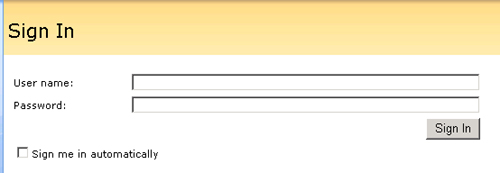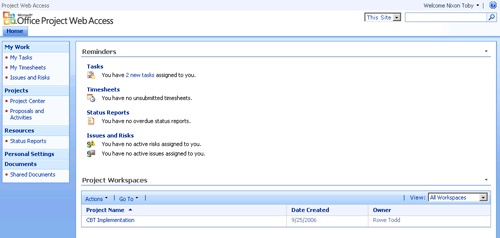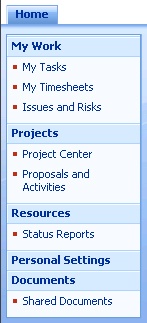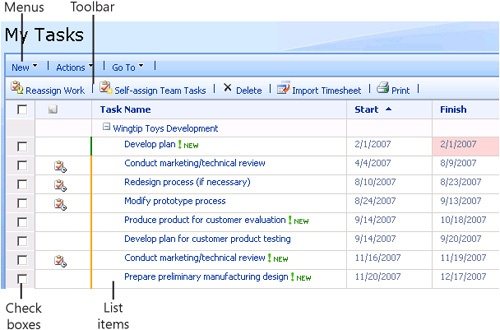A project plan might make an impressive report or boardroom presentation. But without resources to implement the tasks, that lovely project plan is nothing more than fiction. As a project team member, you know that it falls to you to help achieve the goals of the task. You also know that you must regularly inform the powers that be of your progress so that they know how the project is doing overall.
This is where you and Microsoft Office Project Web Access come on the scene. You use Office Project Web Access, the Web-based application for project team members that is a companion to Microsoft Office Project Professional 2007 (used by project managers). You use Project Web Access to maintain a detailed list of the tasks under your responsibility, to know when they’re due, and to understand how they fit into the larger project picture. You also use Project Web Access to track your progress on assignments and submit that information to your project manager. If needed, you can use Project Web Access to log the amount of time you’re spending for other tasks—project-related or not, billable or not.
Project Web Access doesn’t limit you to just one project, either; rather, you can use it for as many projects as you’re contributing to. And if you’re working for two or three project managers at a time on these multiple projects, you can use Project Web Access to keep all this information straight and keep all project managers well-informed.
With project management more automated like this, you can spend more time working on your tasks and less time worrying about keeping management up to date. To this end, this chapter is designed for the project team members, team leads, and resource managers, all of whom use Project Web Access to carry out their project-related responsibilities.
To start using the Microsoft Project enterprise and team collaboration features, you use your Web browser to connect to your organization’s installation of Microsoft Office Project Server 2007. You can then log on to Project Web Access.
Note
If you’re curious about the structure and flow of information among Project Web Access, Office Project Professional, and Office Project Server 2007, see Chapter 20.
After your project manager publishes a project to the project server, you can see and work with the list of tasks to which you’re assigned in Project Web Access. You can add more tasks and assign yourself to other tasks as needed. Project Web Access becomes the central location for all your project tracking activity.
With your assignments in place, your way is set to start working on those assignments, according to the established start and finish dates. While you work, you can record how far along you are on each assignment or even how much time you’re spending on each assignment. You can make notes about any potential problems, significant accomplishments, issues, or potential problems. Then you have progress tracking information in place when your project managers ask for a progress update or status report.
The microcosm of your own tasks draws your focus most of the time. But sometimes it helps you to see the tasks that others on the project team are working on at the same time. You can use Project Web Access to review the full project schedule, which shows who’s doing what when.
Through Project Web Access, you have access to collections of project-related documents, issues, and risks as well.
In addition to everything else you do, you might have resource management responsibilities. This might be something as simple as reassigning a few tasks to peers on your project team. Or, you might be the team lead or supervisor over a larger group of project team members. You might be a resource manager responsible for building teams and managing all resources on one, two, or many projects in your organization. Resource management features in Project Web Access make sure you have the tools you need.
Note
Project server administrators and portfolio managers should see Chapter 21. Project managers can refer to Chapter 22. Managing stakeholders can find pertinent information in Chapter 24. Chapter 24, along with this chapter, are provided as standalone e-chapters on the Bonus Content tab of the Companion CD.
The first step, of course, is to start. You use your Web browser to connect to your organization’s installation of Project Server. You then log on to the server from Project Web Access using the user identification established for you by the project server administrator.
After you’re logged on, browse around to orient yourself to the layout of Project Web Access. This will give you some idea of how you can use Project Web Access as a partner in your assignment-tracking activities.
To log on to Project Web Access, follow these steps:
Start Microsoft Internet Explorer (at least version 6.0).
In the Address box, enter the URL for your organization’s project server and then click Go.
Your project manager or project server administrator provides you with the URL you need. Enter the URL exactly as provided, including any case sensitivity.
If you are set up with a Forms account, the Project Web Access Sign In page appears (see Figure 23-1).
Enter your user name and password as set up by the project server administrator and then click Sign In.
Your user name here might be the same as for your corporate Windows account that you use to access your corporate network, e-mail, and so on. If your project server administrator set you up to use your Windows account, the Sign In page does not appear, and you connect to Project Web Access immediately.
Alternatively, your project server administrator might have set you up with a separate project server account, called a Forms account. In this case, you’ll need to enter that user name and the password that have been provided to you. You might need to add or change your password after you log on the first time.
Your Project Web Access home page appears (see Figure 23-2).
Note
If your project server administrator set you up with a separate project server Forms account, add a password the first time you log on to Project Web Access.
On the Quick Launch task bar, click Personal Settings. Click Change Password. Follow the instructions on the page that appears and then click Save.
When you are finished working with Project Web Access for the time being, it’s important to log off. Because you have special permissions set up just for you in your Project Web Access user account, and you have access to possibly sensitive or proprietary project information and documents, it’s important to practice your normal standards of corporate security.
Working with Project Web Access is like working with most Web sites—you have content, links, and multiple pages.
On the page that’s currently displayed, review what’s available. Remember to use your scroll bar if it’s showing. Click around and orient yourself to the content and controls. If you have used Microsoft Windows SharePoint Services or previous versions of Project Web Access, much of the site will seem familiar.
The Project Web Access home page and other major pages show the Quick Launch task bar on the left side of the screen (see Figure 23-3). The Quick Launch task bar includes a list of links to all the major areas and functions throughout Project Web Access, for example, the Project Center, the Resource Center, and Shared Documents. Simply click a link on the Quick Launch task bar, and the page changes to show the item you clicked.
The home page is the first Project Web Access page you see when you log on. By default, it includes a list of items that need your attention, for example, tasks that have been newly assigned or progress updates that are being requested by your project manager. Your project server administrator sets up your home page to include the content most appropriate for your organization.
All pages throughout Project Web Access have certain standard controls, as follows:
Welcome button. In the upper-right corner of every page is a button that says Welcome with your user name. Click this button to see a menu that includes My Settings, Sign In As Different User, Sign Out, and Personalize This Page.
Help button. Next to the Welcome button is the Help button. If you ever need assistance while using Project Web Access, click the Help button. The Project Server Help window appears. A Help topic pertaining to the current page appears, but you can find other Help topics by typing a phrase or question in the Search For box or by clicking the Home button in the Help window and then browsing through the Contents.
Home. The Home tab is visible on every page. Click this tab to quickly move from an inside page on the Project Web Access site to the home page.
On most pages, such as the My Tasks page or the Project Center, there are additional standard controls, as follows:
Settings. Click the Settings menu on the right side of the menu bar. On most pages, this menu includes View Options. This opens a pane that provides methods for you to control what you’re seeing in the table, for example, a type of filter or a date range. On other pages, the Settings menus might also include commands to Filter, Group, and Search. Clicking one of these commandsalso open a pane providing the necessary controls.
Select a view. Click the arrow in the View box to see a list of views. Views are different versions or layouts of content related to the current page. Some pages have just a single view, whereas others might have seven or eight views.
Several pages throughout Project Web Access include a grid, or table, which lists information such as tasks, timesheets, or projects (see Figure 23-4).
Figure 23-4. You use tables throughout Project Web Access to view and edit project-related information.
The following elements are present in most tables:
List items. The main feature of a table is the list of items. In most cases, you can click an item to drill down, for example, to edit task details or review project details.
Check boxes. Some tables include check boxes next to each listed item. Selecting the check box marks the item for further action, typically with a menu item. Items that are selected can be viewed to the right of the table.
Menus. Two or three menus are typically above a table, for example, New, Actions, and Go To. Click the menu name to view the drop-down menu of commands.
Toolbar. Several buttons are on a toolbar directly above the table. Typically, these buttons are for frequently used commands that are also available on a menu. For example, the My Tasks page includes buttons for Reassign Work, Delete, and Print.
Print the table. You can print the My Tasks, Gantt view, Timesheet, Project Center, and Project Details pages, among others. Click Actions, Print or Print Grid. A printable version of the table appears. Use the Print command in your Web browser to print the table.
Export the table to Excel. You can export tables to Microsoft Office Excel. On the page with the table, click Actions, Export Grid To Excel. The contents of the table appear in an Office Excel spreadsheet. Save the spreadsheet.





